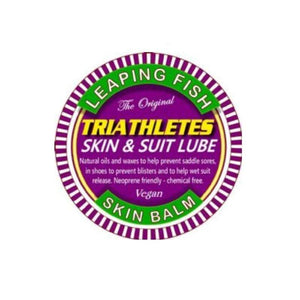
Product Insights
Discover more about the products in this article

Triathletes Skin & Suit Lube
Featured Products
Tips for Effective Transitions in Triathlon
What is Triathlon?
Triathlon is a multi-discipline race comprising of three stages-swim, cycle, run.
What is Transition?
Transition refers to the time between stages, Swim to Cycle (T1) Cycle to Run (T2). In this time, you will change your gear/accessories according to which leg of the race you are going into next.
The transition phase in Triathlon can make or break a race. Small mistakes can cost valuable seconds that could make all the difference when you’re going for your next PB.
Here are some of our top tips for a smooth transition.

T1: Swim-Bike
Use an Anti-Chafe Product:
This will make a huge difference when it comes to removing your wetsuit. Apply to arms and legs to reduce the friction that makes it so difficult to remove a wetsuit after swimming.
A product like the Triathletes Skin & Suit Lube from Leaping Fish is perfect for this.

Kick a little harder:
In the last 200m or so of the swim, try to kick your legs just a little bit harder. This will encourage your body to pump more blood to your muscles, making it easier once you’re back upright on dry land.
Start removing your wetsuit straightaway:
Unzip your wetsuit as soon as you can once out of the water. On your way to T1 you can remove the top half of your wetsuit- down to your waist. This will speed things up once you reach your transition area.
Don’t get carried away:
Resist the urge to sprint as soon as you’re out of the water. This can result in dizziness while your body is adjusting to being back on land. Either walk or jog to T1 and give your legs time to catch up.
Be Organised:
Aim to arrive early on race day, giving yourself plenty of time to lay out your kit in order. You should also make sure that all the kit in your transition area is essential, any extra gear will only get in your way and slow you down. You will not regret this.
You should also make sure to separate wet swim gear from your cycle and run kit.
Have your helmet ready:
Leave your helmet unclipped, handing on the handlebars of your bike. This will allow you to avoid wasting time fumbling with the clip.

T2: Cycle-Run
Perfect Dismount:
Perfecting your dismount is crucial and can be just as, if not more, difficult as mounting the bike. By this point you will be fatigued and the potential for error will be greater.
Make sure to start slowing down as you come up to the dismount line, swing one leg over the bike and step off the bike. It’s important to keep moving forwards here, you don’t want to come to a complete stop to dismount, this will only waste time.
You must dismount before crossing the dismount line or you may incur a penalty.
Use the bike:
Use the bike to steady yourself as you run towards T2. Your legs will be in cycle mode so you might need the extra support whilst they adjust to your feet being back on the ground.
Organisation:
Once again, make sure your kit for the run is already laid out at the start. Remove your helmet and change into your running shoes.
Remember: Don’t take your helmet off until your bike is in the rack! You could also receive a penalty for this.
Prepare your shoes:
Leave your shoes unlaced and open, ready to slip on as quickly as possible. You may even prefer to opt for elastic laces, for example Lock Laces. These don’t need to be tied and can save you valuable time.

Start slow:
When heading into the run, don’t set off to fast. Triathlon is an endurance event, and you will only pay for it later. Setting off fast may also cause ‘jelly legs’.
Practice:
You must practice your transitions! Even if you take all our advice on the day, without practice you won’t be able to perfect your routine.
Make time in your training schedule to practice each transition.

Mastering the transition is sometimes overlooked by beginners in Triathlon, but there’s a reason it’s often referred to as the fourth discipline.
Like we said before, completing a smooth transition will hugely improve your overall race. So, take our advice and get practicing!
Related Articles:
Answering the Top Googled Triathlon Questions


